西方饮食文化英语
- 格式:ppt
- 大小:3.81 MB
- 文档页数:2

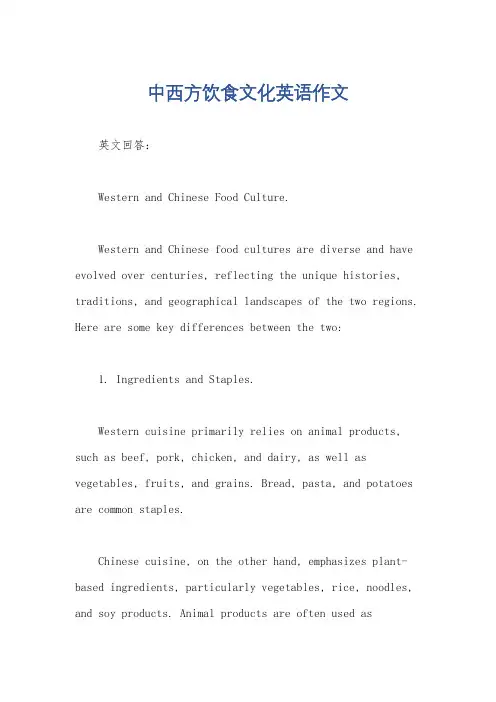
中西方饮食文化英语作文英文回答:Western and Chinese Food Culture.Western and Chinese food cultures are diverse and have evolved over centuries, reflecting the unique histories, traditions, and geographical landscapes of the two regions. Here are some key differences between the two:1. Ingredients and Staples.Western cuisine primarily relies on animal products, such as beef, pork, chicken, and dairy, as well as vegetables, fruits, and grains. Bread, pasta, and potatoes are common staples.Chinese cuisine, on the other hand, emphasizes plant-based ingredients, particularly vegetables, rice, noodles, and soy products. Animal products are often used ascomplements or flavorings rather than the main components of dishes.2. Cooking Methods.Western cooking methods include grilling, roasting, frying, and baking, which emphasize the natural flavors of the ingredients. Seasonings are typically used sparingly.Chinese cooking techniques are more varied and include stir-frying, steaming, braising, and deep-frying. Chinese cuisine places a strong emphasis on balancing flavors and textures, using a wide range of seasonings and sauces.3. Presentation.Western food presentations often prioritize aesthetics and individual portions. Dishes are typically served on plates with separate compartments for different items.In Chinese cuisine, dishes are often served communally on large plates or platters. The communal aspect reflectsthe importance of sharing and family in Chinese culture.4. Dining Customs.Western dining customs are influenced by etiquette and formality. Meals are typically served in courses, with specific utensils assigned for each item. Guests are expected to follow certain table manners and conversation rules.Chinese dining customs are more relaxed and social. Chopsticks are used to eat most meals, and dishes are shared among guests. Conversation and laughter are encouraged during meals.5. Meal Structure.Western meals typically consist of three main courses: breakfast, lunch, and dinner. Dinner is often the largest and most formal meal of the day.Chinese meals often involve smaller, more frequentportions throughout the day. Breakfast and lunch are typically lighter, while dinner is a more substantial meal. Snacks and dim sum are also popular in Chinese cuisine.6. Cultural Influences.Western food culture has been influenced by a variety of other cultures, including Mediterranean, Middle Eastern, and Asian cuisines. This has resulted in a diverse range of dishes and flavors.Chinese food culture has also been influenced by other Asian cuisines, such as Japanese and Korean, as well as by its own regional variations.中文回答:西方饮食文化和中国饮食文化。
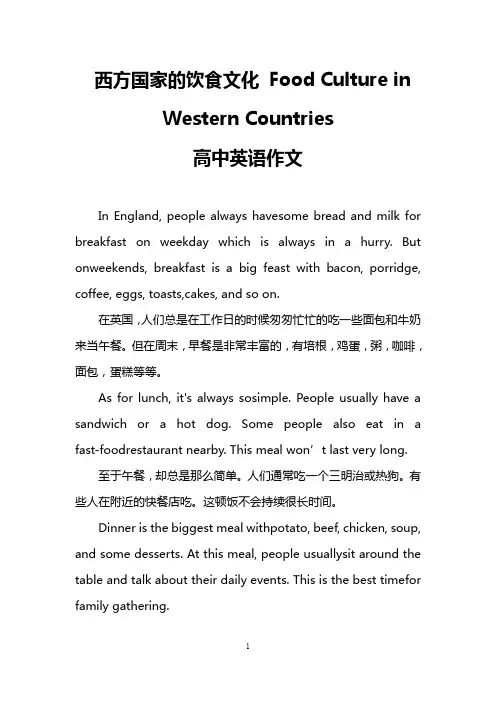
西方国家的饮食文化Food Culture inWestern Countries高中英语作文In England, people always havesome bread and milk for breakfast on weekday which is always in a hurry. But onweekends, breakfast is a big feast with bacon, porridge, coffee, eggs, toasts,cakes, and so on.在英国,人们总是在工作日的时候匆匆忙忙的吃一些面包和牛奶来当午餐。
但在周末,早餐是非常丰富的,有培根,鸡蛋,粥,咖啡,面包,蛋糕等等。
As for lunch, it's always sosimple. People usually have a sandwich or a hot dog. Some people also eat in a fast-foodrestaurant nearby. This meal won’t last very long.至于午餐,却总是那么简单。
人们通常吃一个三明治或热狗。
有些人在附近的快餐店吃。
这顿饭不会持续很长时间。
Dinner is the biggest meal withpotato, beef, chicken, soup, and some desserts. At this meal, people usuallysit around the table and talk about their daily events. This is the best timefor family gathering.晚餐是最丰富的有土豆,牛肉,鸡肉,汤,和一些甜点。
在这顿饭中人们通常坐在桌子旁边谈论他们的日常活动。
这是家庭聚会的最佳时间。
Cheese is the most popular foodin European countries and the United States. According to different dishes andwine, different cheese is tied in. The simplest cheese is to put a certainamount of all kinds of cheese on a plate, called cheese dish.在欧洲国家和美国奶酪是最受欢迎的食品。
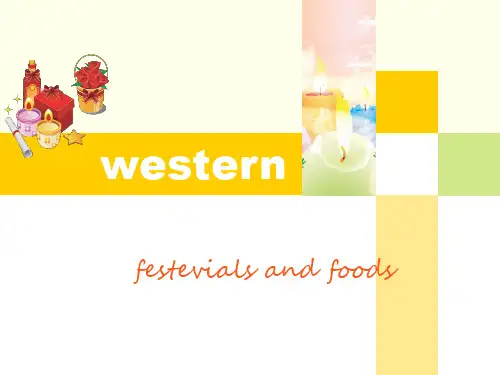
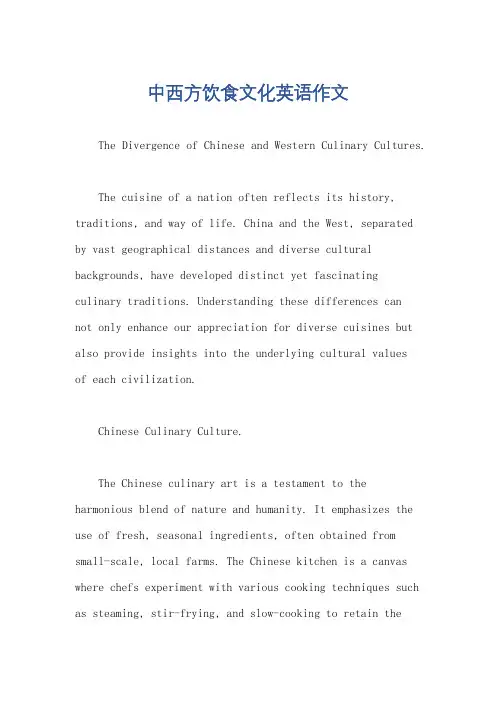
中西方饮食文化英语作文The Divergence of Chinese and Western Culinary Cultures.The cuisine of a nation often reflects its history, traditions, and way of life. China and the West, separated by vast geographical distances and diverse cultural backgrounds, have developed distinct yet fascinatingculinary traditions. Understanding these differences cannot only enhance our appreciation for diverse cuisines but also provide insights into the underlying cultural valuesof each civilization.Chinese Culinary Culture.The Chinese culinary art is a testament to the harmonious blend of nature and humanity. It emphasizes the use of fresh, seasonal ingredients, often obtained from small-scale, local farms. The Chinese kitchen is a canvas where chefs experiment with various cooking techniques such as steaming, stir-frying, and slow-cooking to retain thenatural flavors of ingredients.The Chinese diet also reflects a deep respect for balance and harmony. The concept of "Yin and Yang" plays a crucial role in Chinese cooking, where dishes are often prepared to balance the five elements of taste: sour, sweet, bitter, salty, and umami. Furthermore, Chinese cuisineoften incorporates medicinal properties of ingredients, aiming to nourish and heal the body.The preparation of Chinese food often involves a complex sequence of steps, requiring meticulous attentionto detail. From marinating meats to perfecting the stock, each dish is a labor of love, reflecting the respect and appreciation for food among the Chinese people.Western Culinary Culture.In contrast, Western cuisine tends to emphasize flavor and texture through the use of various cooking fats, sauces, and seasonings. The Western kitchen is often equipped witha range of cooking appliances and tools, allowing for moreexperimentation and creativity.Western cuisine also has a strong tradition of meat-based dishes, particularly red meat. This is partially dueto the historical role of hunting and animal husbandry in Western cultures. Additionally, dairy products play a prominent role in Western cooking, with cheeses, butter,and cream being common ingredients in many dishes.The Western palate also tends to favor strong flavors and aromas, often achieved through the use of spices, herbs, and alcohol. Dishes are often served with multiple sauces and condiments, allowing diners to customize their flavor experience.Comparative Analysis.The primary difference between Chinese and Western cuisines lies in their approach to cooking and flavor. Chinese cuisine emphasizes the preservation of natural flavors and textures through gentle cooking techniques,while Western cuisine tends to accentuate flavors throughthe use of fats, sauces, and seasonings.Moreover, Chinese cuisine tends to prioritize balance and harmony, reflecting the cultural values of yin and yang. In contrast, Western cuisine often celebrates the individuality and creativity of chefs, allowing for more experimentation and variety.Finally, the dining experiences themselves differ significantly. Chinese dining often involves shared plates and family-style meals, promoting a sense of community and togetherness. In contrast, Western dining typicallyinvolves individual plates and portions, reflecting a more individualistic dining culture.In conclusion, the culinary traditions of China and the West reflect their respective cultural values and histories. Understanding these differences can enhance ourappreciation for diverse cuisines and provide insights into the rich tapestry of human civilization. As globalization continues to bring diverse cultures together, it isimportant to cherish and respect these differences, allowing us to share the world's culinary riches.。
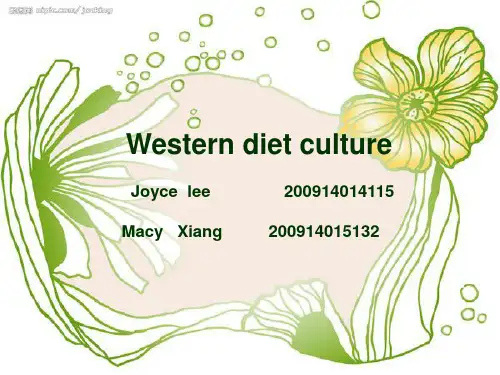
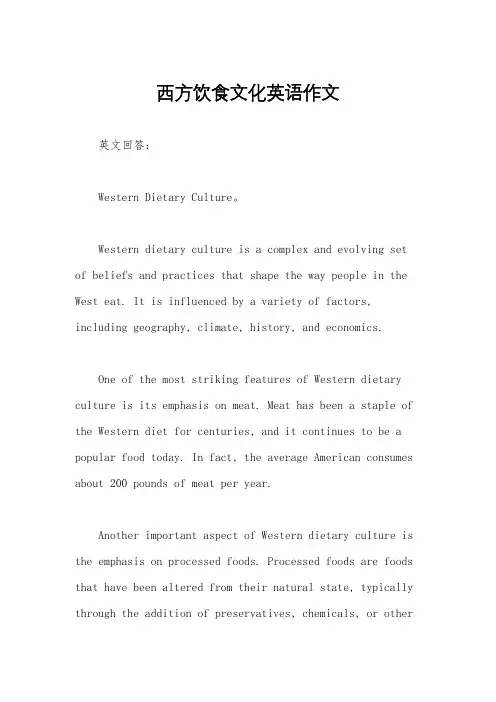
西方饮食文化英语作文英文回答:Western Dietary Culture。
Western dietary culture is a complex and evolving set of beliefs and practices that shape the way people in the West eat. It is influenced by a variety of factors, including geography, climate, history, and economics.One of the most striking features of Western dietary culture is its emphasis on meat. Meat has been a staple of the Western diet for centuries, and it continues to be a popular food today. In fact, the average American consumes about 200 pounds of meat per year.Another important aspect of Western dietary culture is the emphasis on processed foods. Processed foods are foods that have been altered from their natural state, typically through the addition of preservatives, chemicals, or otheradditives. Processed foods are often cheaper and more convenient than fresh foods, and they have become a stapleof the Western diet.The Western diet is also characterized by its highintake of sugar. Sugar is a major source of empty calories, and it has been linked to a variety of health problems, including obesity, heart disease, and diabetes.The Western dietary culture is changing, but it isstill based on the principles of convenience, affordability, and taste. These principles have led to a diet that is high in meat, processed foods, and sugar. This diet has been linked to a variety of health problems, and it is important to be aware of the risks associated with it.中文回答:西方饮食文化。
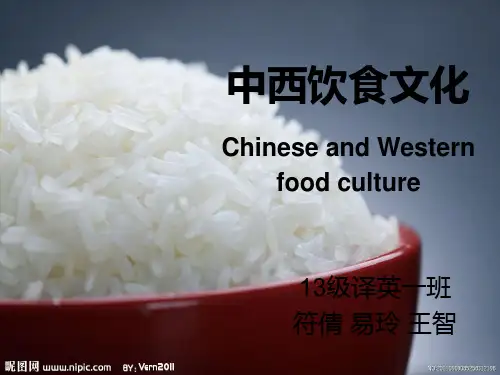
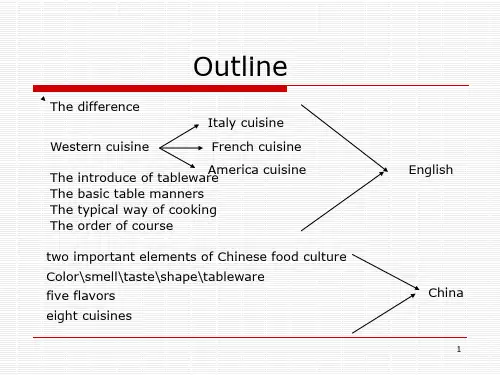

Western cuisine is a diverse and rich culinary tradition that has evolved over centuries,reflecting the history,geography,and cultural influences of various European countries.It is characterized by a wide variety of dishes,cooking techniques,and flavors that have been shaped by the regions in which they originated.Here is a detailed exploration of Western diet culture,highlighting its key aspects and the influence it has had on global gastronomy.Historical DevelopmentThe roots of Western cuisine can be traced back to ancient civilizations such as the Greeks and Romans,who laid the foundation for many of the cooking techniques and ingredients used today.The Middle Ages saw the introduction of new ingredients and spices from the East,which greatly enriched the culinary landscape.The Age of Exploration brought even more variety,as explorers returned from their voyages with exotic foods that were previously unknown in Europe.Key IngredientsWestern cuisine is known for its use of a wide range of ingredients,including meats, dairy products,grains,and vegetables.Meats such as beef,pork,and chicken are staples, often prepared through methods like roasting,grilling,and stewing.Dairy products like cheese and butter are integral to many recipes,contributing to the rich flavors and textures of Western dishes.Grains such as wheat,rice,and barley are used in a variety of forms,from bread and pasta to side dishes and desserts.Cooking TechniquesThe cooking techniques used in Western cuisine are as varied as the dishes themselves. Baking is a common method,used for preparing bread,pastries,and cakes.Roasting is another popular technique,particularly for meats and vegetables,which are often seasoned with herbs and spices.Grilling and barbecuing are also prevalent,especially in the United States,where the barbecue culture is a significant part of the culinary scene.Dining EtiquetteWestern dining etiquette is characterized by a formal structure that has been passed down through generations.Meals are typically served in courses,starting with an appetizer, followed by the main course,and ending with dessert.The use of cutlery is precise,with different utensils used for different types of food.It is customary to wait for everyone to be served before beginning to eat,and to engage in polite conversation throughout themeal.Influence on Global CuisineThe influence of Western cuisine is felt around the world,as many of its dishes and cooking techniques have been adopted and adapted by other cultures.Fast food,for example,which originated in the United States,has become a global phenomenon.The popularity of Italian cuisine,with its emphasis on fresh ingredients and simple preparation,has also spread worldwide,with pizza and pasta becoming staples in many countries.Contemporary TrendsIn recent years,there has been a shift towards healthier eating within Western cuisine. This has led to an increased focus on organic and locally sourced ingredients,as well as a greater emphasis on plantbased dishes.There is also a growing interest in fusion cuisine, which combines elements of Western cooking with flavors and techniques from other cultures,creating unique and innovative dishes.ConclusionWestern cuisine is a testament to the rich and varied culinary heritage of the countries that make up the Western world.Its evolution over time has been influenced by countless factors,from historical events to cultural exchanges.As it continues to adapt and evolve, Western cuisine remains a dynamic and exciting part of the global culinary landscape. Whether youre enjoying a traditional roast dinner in England,a fresh pasta dish in Italy, or a barbecue feast in the United States,the flavors and traditions of Western cuisine offer a rich and satisfying dining experience.。
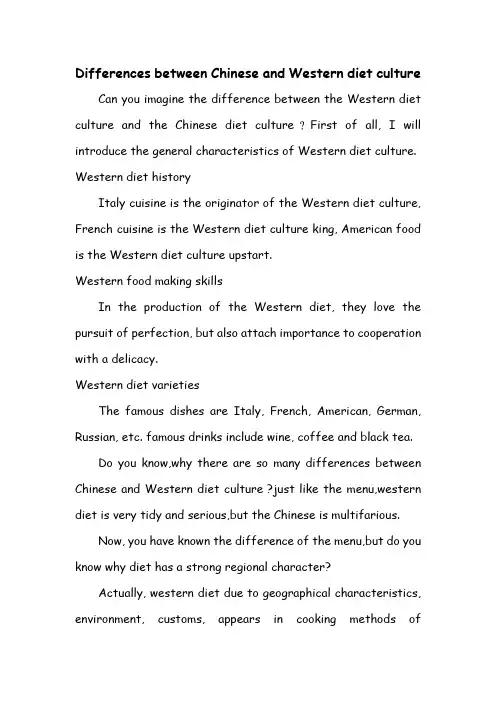
Differences between Chinese and Western diet culture Can you imagine the difference between the Western diet culture and the Chinese diet culture?First of all, I will introduce the general characteristics of Western diet culture. Western diet historyItaly cuisine is the originator of the Western diet culture, French cuisine is the Western diet culture king, American food is the Western diet culture upstart.Western food making skillsIn the production of the Western diet, they love the pursuit of perfection, but also attach importance to cooperation with a delicacy.Western diet varietiesThe famous dishes are Italy, French, American, German, Russian, etc. famous drinks include wine, coffee and black tea.Do you know,why there are so many differences between Chinese and Western diet culture ?just like the menu,western diet is very tidy and serious,but the Chinese is multifarious.Now, you have known the difference of the menu,but do you know why diet has a strong regional character?Actually, western diet due to geographical characteristics, environment, customs, appears in cooking methods ofdifferences in eating habits. People in western countries like to eat pizza, while Chinese people like to eat dumplings.Differences between Chinese and Western culture makes a difference of Chinese and Western food culture.事实上,西方饮食由于地域特色、环境、风俗习惯,出现烹调方法不同程度的差异。
度米作文汇编之高中英语作文:西方国家的饮食文化高中英语作文:西方国家的饮食文化in england, people always have some bread and milk for breakfaston weekday which is always in a hurry. but on weekends, breakfastis a big feast with bacon, porridge, coffee, eggs, toasts, cakes, and so on.在英国,人们总是在工作日的时候匆匆忙忙的吃一些面包和牛奶来当午餐。
但在周末,早餐是非常丰富的,有培根,鸡蛋,粥,咖啡,面包,蛋糕等等。
as for lunch, it's always so simple. people usually have a sandwich or a hot dog. some people also eat in afast-food restaurant nearby. this meal won’t last very long.至于午餐,却总是那么简单。
人们通常吃一个三明治或热狗。
有些人在附近的快餐店吃。
这顿饭不会持续很长时间。
dinner is the biggest meal with potato, beef, chicken, soup, and some desserts. at this meal,people usually sit around the table and talk about their daily events. this is the best time for family gathering.晚餐是最丰富的有土豆,牛肉,鸡肉,汤,和一些甜点。
在这顿饭中人们通常坐在桌子旁边谈论他们的日常活动。
这是家庭聚会的时间。
cheese is the most popular food in european countries and the united states. according to different dishes and wine, different cheese is tied in. the simplest cheese is to put a certain amount of all kinds of cheese on a plate, called cheese dish.在欧洲国家和美国奶酪是欢迎的食品。